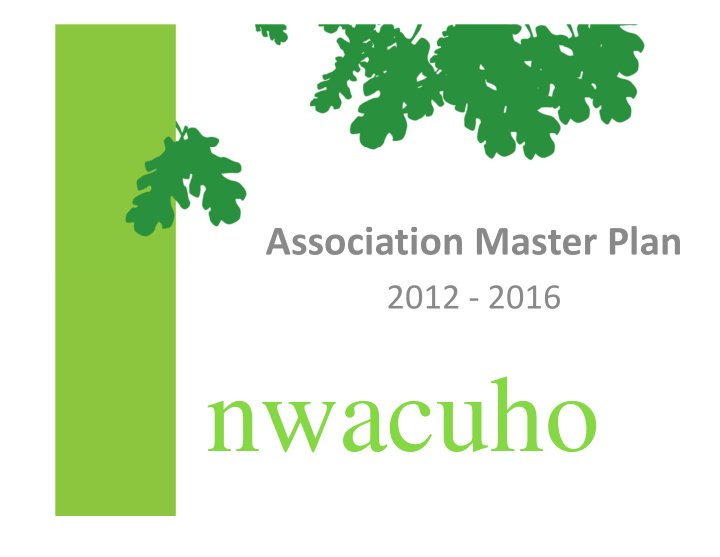



Association Master Plan 2012 - 2016 nwacuho
The Association • 1961 – 1977 • Unincorporated group of housing professionals • 1977 • Formation of first constitution executive committee, and President • 2008 • Filed Articles of Incorporation as an Oregon nonprofit public corporation
The Association • 2011 • Determination of tax exempt status as a 501(c)6 Association • 2012 • Master plan released focusing on the programmatic future of NWACUHO
Service Area • International, multi-state and multi- province organization • US states of Alaska, Washington, and Oregon • Canadian provinces of Alberta and British Columbia • Yukon Territory
Governance NWACUHO is governed by a volunteer Board of Directors who direct the operations of the Association and maintain a fiduciary duty to the well- being of the organization.
Master Planning Purpose Who are we? Who do we serve? Who do we want to be? How are we going to get there?
Premise Our core purpose has not and should not change. How we pursue that purpose can and should.
Master Planning Objectives • Organizational Identity • Vision • Tagline • Mission • The Future • Current Reality, Desired Reality, Outcomes • Deliverable: Five Year Process • Deliverable: One Year Action Items
Master Planning Process February 2011: Master Planning Group Commissioned July 2011: Master Planning Retreat October 2011: Board Approval of Mission, Vision, Tagline Work Session on Action Plan February 2012: Board Approval of Action Plan Presentation to Association
NWACUHO Enriching the housing profession.
Vision Statement Be the higher education housing industry's leading regional association by providing professional enrichment that enhances the residential environment.
Mission Statement To enrich the housing profession through the promotion of best practices, professional development, collaborative sharing of ideas, and the examination of future trends relating to the administration of the physical, financial, social and educational components of university and college housing programs.
Core Purposes NWACUHO exists to: • Promote best practices • Encourage professional development • Foster the collaborative sharing of ideas • Examine future industry trends
The Plan – Focus Areas • Where is there a gap between current reality and the desired situation? • Which issues do we struggle with year after year?
Roadmap to Success 1. Identify and prioritize objectives for each focus area 2. Develop action plans for each objective 3. Implement. 4. Assess. 5. Rinse, recycle, repeat.
Blah blah blah? No, really, this stuff is groundbreaking for us.
Focus Areas • Core Purposes • Financial Stewardship • Governance • Member Engagement • Partnerships
Core Purposes Focus Area We envision a situation where: There is continuity between association programs and core purposes, mission, and vision
Core Purposes Focus Area Key indicators • Task force functionality • Organizational policies and procedures • Member awareness of core purposes
Financial Stewardship Focus We envision a situation where: NWACUHO will have sound, codified financial practices and procedures in place that exemplify non-profit industry best practices.
Financial Stewardship Focus Key indicators: • Reserve policies • Audit policies • Financial policies and procedures • Program funding priorities • Revenue practices
Governance Focus Area We envision a situation where: Efficient, effective, functional, and inclusive governance and operating structure for the Association is present.
Governance Focus Area Key indicators: • Structure and responsibilities of Board positions • Election process and cycle • Board member accountability • Recruitment of Board members • Documentation of organizational precedents
Member Engagement Focus Area We envision a situation where: A culture of long term engagement and continued contribution is present, and opportunities for progression of involvement and participation at all levels exists.
Member Engagement Focus Area Key indicators: • Senior Housing Officer involvement • Lifecycle of a member • Task force effectiveness • Institutional membership • Corporate membership • Conference program
Partnerships Focus Area We envision a situation where: Strategic partnerships exist that add value to the association, are related to core purposes, and demonstrate return on investment.
Partnerships Focus Area Key indicators: • AIMHO and RLPA relationships • PACURH relationship • ACUHO-I affiliation • ACUHO-I Foundation support • Functional association relationships
Objective Prioritization • High: Areas that need attention in the near term, within the next 1 – 2 years. • Medium: Areas that need attention in the midterm, within the next 2 – 3 years. • Low: Areas that need attention in the long term, within the next 3 – 5 years or beyond.
2012 Objective Implementation Core Purposes: Establish decision making guidelines for scholarships, awards, funding proposals, programs, and other initiatives that consider core purposes as a litmus test for the business of the association. Incorporation of core purposes in all decision making processes.
2012 Objective Implementation Financial Stewardship: Develop an efficient funding request and decision making process/structure that utilizes core purposes as a metric. Develop expense procedures with appropriate levels of internal and external financial controls for a non-profit association.
2012 Objective Implementation Governance: Determine whether the current Board structure meets the association’s vision and mission. Clearly document roles, expected outcomes, and responsibilities through task lists, position descriptions, and goals.
2012 Objective Implementation Member Engagement: Create a structure to integrate and orient new professionals to the region and develop cycle of progressive involvement opportunities through mid-level to senior level.
2012 Objective Implementation Partnerships: Analysis of connection to core purposes and if affiliation with current partnerships is to be continued, formalization through a memorandum of understanding or affiliation agreement.
What’s next? 1. Implement actions steps for 2012 2. Select objectives for 2013 attention based on priority 3. Don’t worry, we have 24 objectives. 4. Revise plan in 5 years
For More Information Josh Gana Past Past President jgana@uw.edu Steve Fitterer Past President sfitterer@mtroyal.ca
Recommend
More recommend